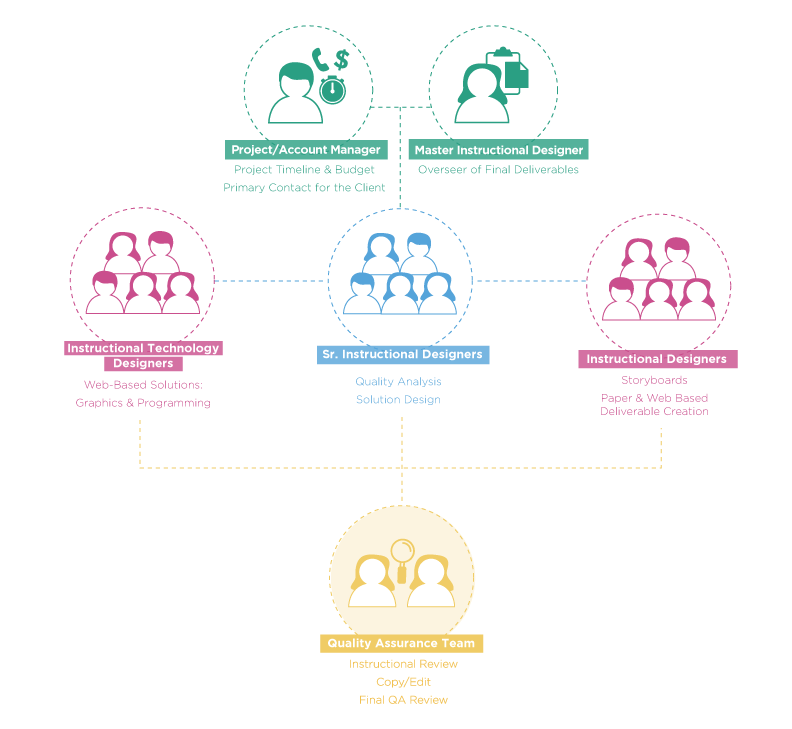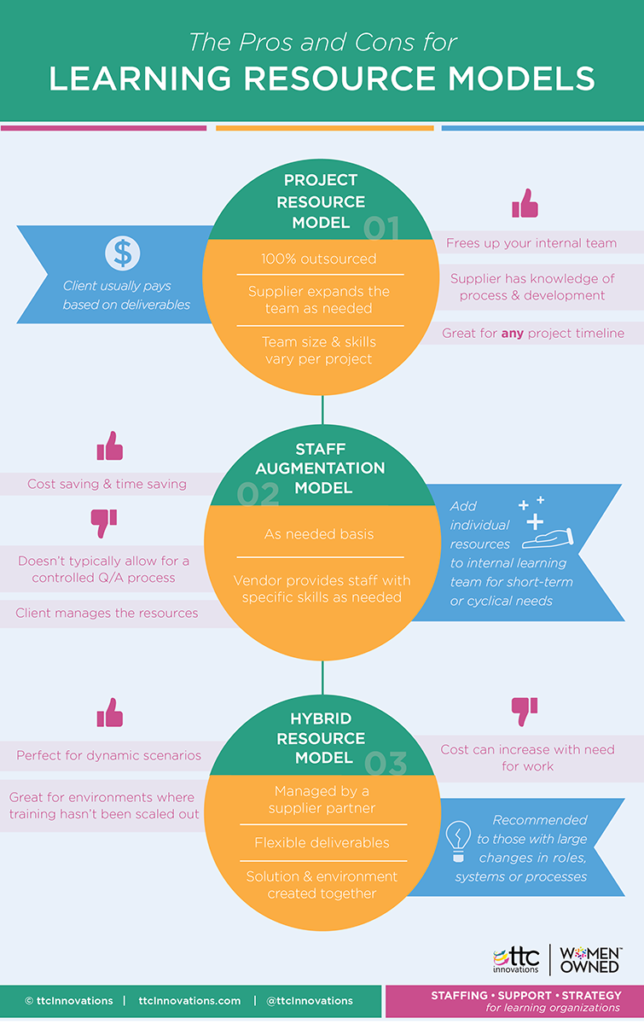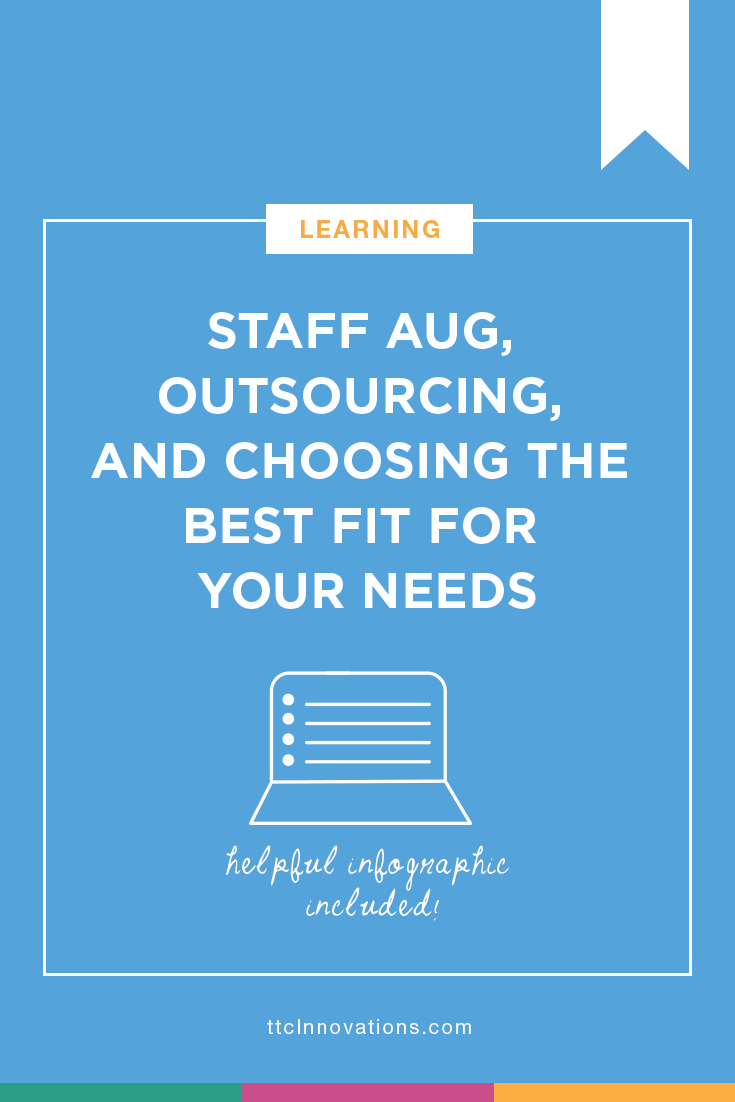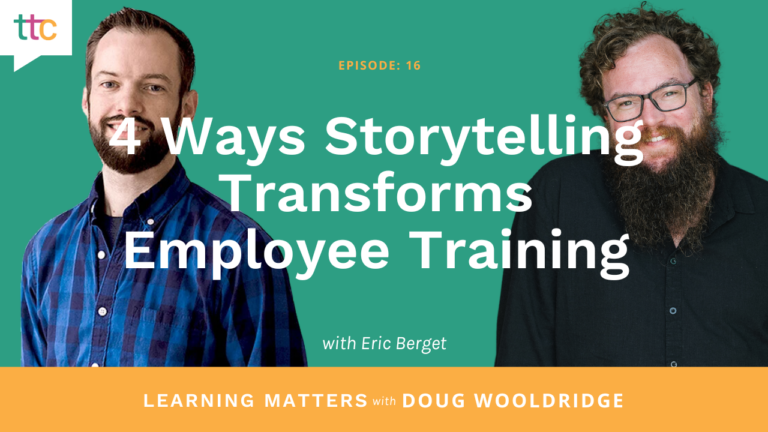If you don’t have a well-loved and trusted training supplier that you work with today, I know it can be scary to hand over your precious learning and development project to outsourcing strangers. But don’t worry, I have some great questions you can start contemplating before you engage with a new supplier!
Training Development Resource Models
Depending on your training initiative, you’ll find that there are three basic resourcing models:
- Project Resource Model (outsourcing)
- Staff Augmentation Model (or as we like to call it, Innovators on Demand™!)
- Hybrid Resource Model
Project Resource Model (outsourcing)
This model provides the ability to outsource an entire project. The supplier will manage the day-to-day training development tasks and activities during the project life cycle, which frees up your internal learning team to work on other initiatives. This project model also allows for the supplier to expand their team as needed to meet the timeline. The team consists of a number of resources with specific skill sets who can move in and out of the project as needed for completion of tasks.
The client is typically paying based on the finished deliverable (think web-based training, virtual instructor-led courses, job aids, etc.), not the time it takes to complete each course or how many resources are decked to the project.
This model works best with projects that have defined deliverables, where the supplier has a working knowledge of development process expectations from the client (for example, number of subject matter experts [SMEs], number of review cycles, the client’s Learning Management System [LMS], and functional requirements).
Here’s a peek at the ttcInnovations Project Resource Model…

Innovators on Demand™ | Staff Aug Model
The staff augmentation model is very popular, as it allows companies to add to their team based on the specific skills needed to cover a temporary staffing gap. This is a great way to add a few individual resources to an internal learning team for short-term or cyclical needs while saving the cost and effort of hiring employees. In this type of model, the client has full management responsibilities for the staff augmentation resource, and the resource is fully integrated into the internal learning team. Some training may be required to bring the resource up to speed.
The wonderful thing about this model is that the outsourcing or supplier partner is responsible for all the upfront work of acquiring, interviewing, and matching the right resource for the client’s company, team, and needs. This can save a business time and money!

One FREE Week!
New clients, tap into our talent with one week of Innovators on Demand® on us.
Get started with one of our skilled Innovators.
Hybrid Resource Model
Some initiatives don’t fit easily into either of the above models. Typically, this happens when a project is associated with a large business change that involves systems, processes, and roles. For example, the environment in which training is being created may not be fully scaled out, and the training solution is being built parallel with the creation of the new environment. This means there would be a high need for the training team to be very flexible with stopping, starting, shifting, and reworking deliverables.
This model is similar to the project resource model, but with consistent resources who can be flexible with timelines changes and shift between multiple deliverables based on what is ready. This team is managed by the supplier partner. The cost of this model is higher due to the needs of accommodating rework, adding new deliverables, and organizing meetings to gather ever-changing information.

Choosing The Best Fit for YOUR Needs
If you have a good learning development outsourcing partner, they will provide recommendations based on your situation and working outcomes. The following are some initial questions I use when formulating a recommendation for our clients:
- What is happening to create the need for a training solution?
- What are the expected outcomes once a person completes training and is back on the job?
- Does the work have definitive deliverables, or are there a variety of tasks that need to be completed as they are identified by an internal manager
- What is the likelihood of the identified deliverable changing during the project life cycle?
- Are the business’s processes, responsibilities, and tasks associated with the work stable or in flux?
- What are the working styles of the project team, business partners, and subject matter experts?
- What are the specific skill sets needed to complete the work successfully?
- What is the project timeline?







